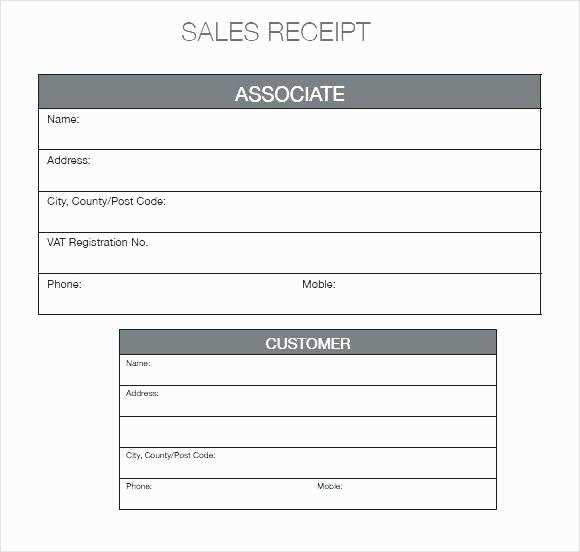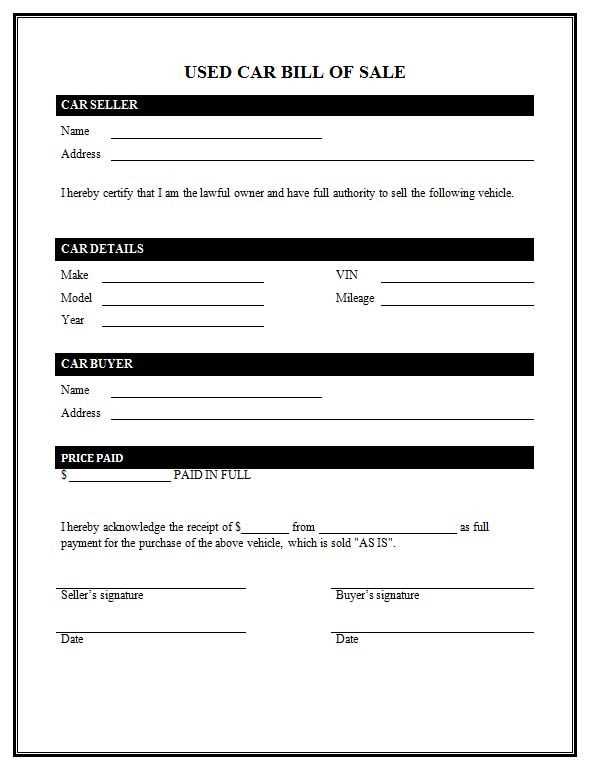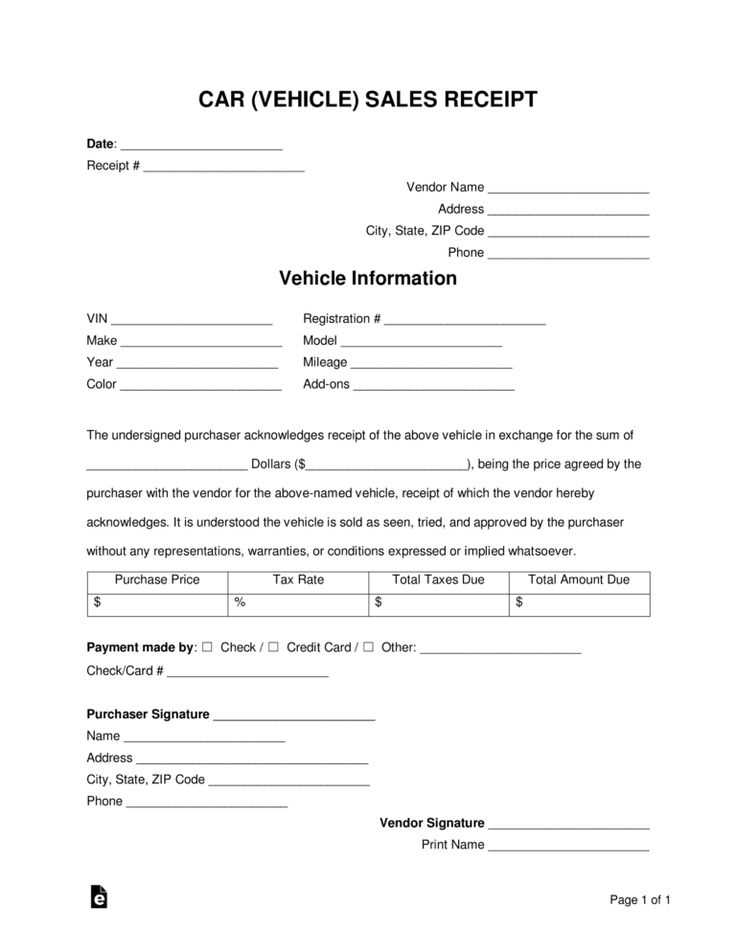
Creating a car sale receipt is a straightforward process that protects both the buyer and seller. A properly written receipt not only serves as proof of the transaction but also helps clarify terms agreed upon by both parties. It’s important to ensure that the document includes all relevant details about the car and the sale itself.
Include the basic information: Start by noting the date of the transaction, along with the buyer’s and seller’s full names and addresses. Be sure to include the car’s make, model, year, VIN (Vehicle Identification Number), and the odometer reading at the time of the sale. This information is vital for any future references or legal purposes.
Specify the terms: Clearly state the sale price and the method of payment. If there were any warranties, guarantees, or conditions attached to the car sale, these should be mentioned in detail. This will help avoid misunderstandings later on.
Ensure signatures: Both the buyer and seller should sign the receipt to confirm the agreement. If necessary, include a space for a witness signature. This adds another layer of security and validity to the transaction.
How to Include Vehicle Details in a Receipt
Ensure the receipt contains the full and accurate vehicle information to avoid disputes. Begin with the vehicle’s make, model, and year. Specify the vehicle identification number (VIN) as it uniquely identifies the car. Next, include the odometer reading at the time of sale, which helps confirm the car’s mileage. For added clarity, list the color and type of the vehicle. If there are any relevant accessories or modifications, document these as well to avoid confusion.
Specific Vehicle Identifiers

Include the VIN in a clear, readable format. This number is crucial for legal and registration purposes. Ensure that it matches the one on the title and registration documents. If any discrepancies arise later, the VIN can resolve issues quickly.
Additional Information to Include

If applicable, mention any warranties, recalls, or service history. This information can provide the buyer with a complete understanding of the vehicle’s condition. If you are selling a vehicle with a title transfer, include the title number as well to simplify the process for both parties.
Determining the Sale Price and Payment Method
Set a fair sale price based on the car’s current market value. Consider factors like the car’s age, mileage, condition, and any modifications or repairs. Look at listings for similar cars to gauge a competitive price range. Use online pricing tools and consult a professional appraiser if necessary.
Setting the Price
To establish a reasonable price, assess both the buyer’s and seller’s expectations. A transparent history of the vehicle’s maintenance and accident records can justify a higher price, especially for well-maintained models. If the car has any unique features or recent upgrades, factor those in. Avoid setting the price too high, as this may deter potential buyers, or too low, as it might lead to an undervaluation.
Choosing a Payment Method

Payment methods must be clear and secure. Cash payments are common for quick transactions, but they can pose risks, especially for large sums. Bank transfers or certified checks are safer alternatives. You can also consider installment plans if the buyer is interested, but ensure all terms are clearly written in the sale agreement to avoid any disputes later.
Adding Seller and Buyer Information
Clearly list the seller and buyer’s full names, addresses, and contact details. These details should be placed at the top of the receipt for quick reference. Include the seller’s legal name as registered and the buyer’s information exactly as it appears on their ID or official documents.
Seller’s Information
Provide the seller’s full legal name, address, phone number, and email address. This ensures proper identification of the person transferring ownership of the vehicle. If applicable, include the seller’s business name if the sale occurs through a dealership.
Buyer’s Information
Similarly, list the buyer’s full legal name, address, phone number, and email address. Double-check that the buyer’s information matches their ID to avoid future disputes. For added security, note the buyer’s driver’s license number, if relevant.
Including Warranty or “As-Is” Clause
Specify clearly whether the vehicle comes with a warranty or is sold “as-is.” If the sale includes a warranty, outline the terms, including the coverage period, conditions for repairs, and any exclusions. Define what is covered, such as mechanical issues or parts replacement, and mention any requirements for the buyer to claim warranty services, such as regular maintenance.
On the other hand, if the vehicle is sold “as-is,” make sure this is explicitly stated in the receipt. An “as-is” sale means the buyer accepts the vehicle in its current condition, with no guarantees of functionality or repairs from the seller. This clause protects the seller from future claims related to the vehicle’s performance or condition after the sale.
Clearly explaining these options ensures transparency and reduces the likelihood of disputes after the transaction. Always consult a legal professional to ensure the warranty or “as-is” clause complies with local laws and regulations.
Terms of the Sale and Final Agreement
Ensure both parties review the terms outlined in the sale agreement before signing. This will prevent misunderstandings and clarify expectations for both the buyer and the seller. Below are key elements to consider when finalizing the sale:
- Payment Method: Confirm the agreed-upon method, whether it’s a bank transfer, certified check, or other accepted forms. Clearly state the payment due date and any applicable fees or taxes.
- Vehicle Condition: Acknowledge the condition of the car at the time of sale. If the car has any existing issues, both parties must agree on what will be repaired before completion of the sale.
- Warranties and Guarantees: Clearly indicate any warranties provided, whether manufacturer or seller. If no warranties are given, explicitly state the vehicle is sold “as is” to avoid future claims.
- Transfer of Ownership: Include the date the ownership will transfer to the buyer. This will typically coincide with full payment. Ensure the buyer receives all necessary documents, such as the title and registration.
- Delivery or Pickup: Agree on the logistics of the vehicle transfer, including the location and any potential costs for delivery or pickup.
- Final Agreement Clause: Make it clear that once the agreement is signed, both parties are legally bound by the terms outlined in the contract. Any changes or additions must be documented in writing.
Both parties should sign and date the document, ensuring each has a copy for their records. The final agreement should be free from ambiguities, leaving no room for disputes after the transaction is complete.
Legal Considerations and Required Signatures
Always include the full legal names of both the buyer and seller in the receipt. Make sure the sale price, the car’s VIN (Vehicle Identification Number), and the make and model are clearly listed. It’s vital to state that the car is sold “as-is” unless a warranty is provided. Clarify if the seller is guaranteeing the vehicle’s condition or not.
Both parties should sign the document. The buyer’s signature confirms acceptance of the sale, while the seller’s signature validates the transfer of ownership. For added clarity, consider including a witness signature or notary public seal, depending on local requirements. This can help prevent future disputes over the transaction’s validity.
In some jurisdictions, a date of sale should be recorded to ensure the accuracy of the transaction’s timeline. Be sure to check if your state or country has any specific regulations regarding sales receipts for vehicles. In some places, the buyer may need to submit a copy of the receipt to the DMV or other relevant authorities to register the vehicle under their name.
If you have a loan or lien on the vehicle, include a statement that it is paid off or that the buyer assumes responsibility for any outstanding debts related to the car. This is especially important in avoiding any misunderstandings after the sale is complete.


